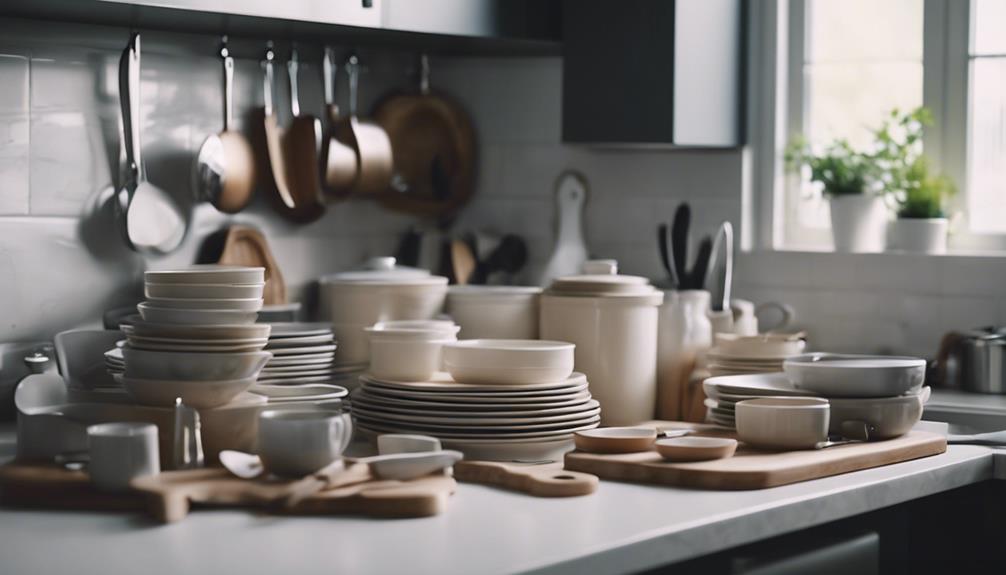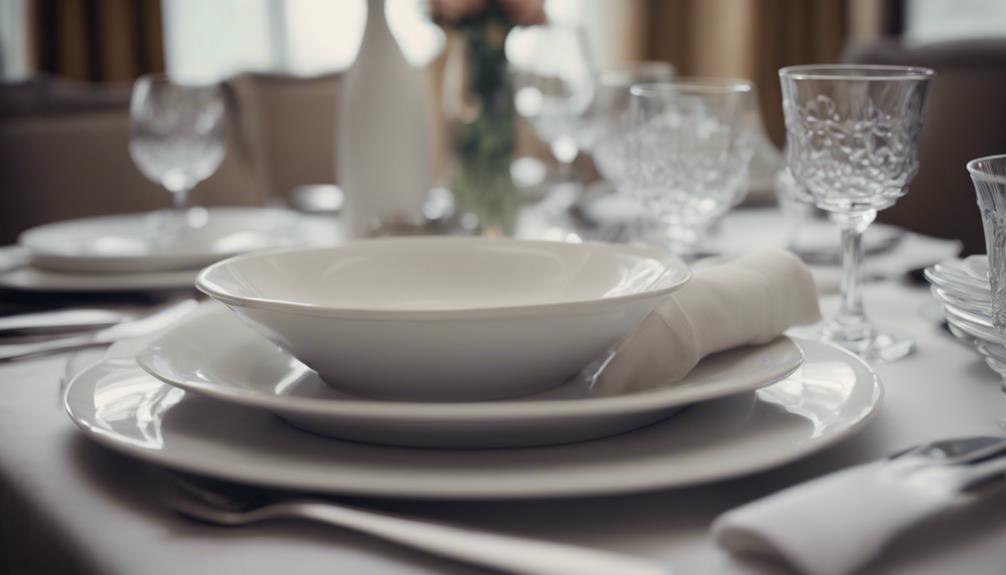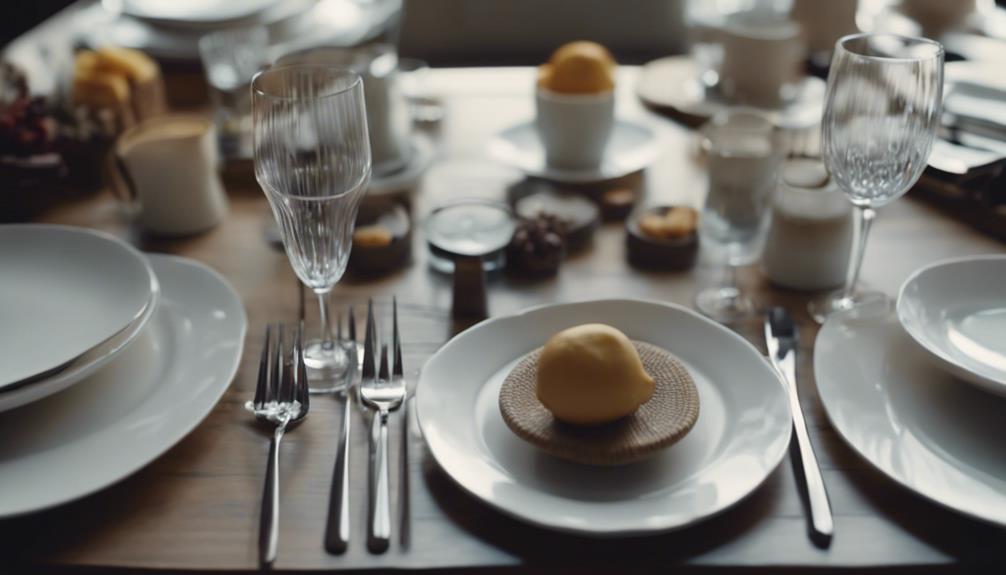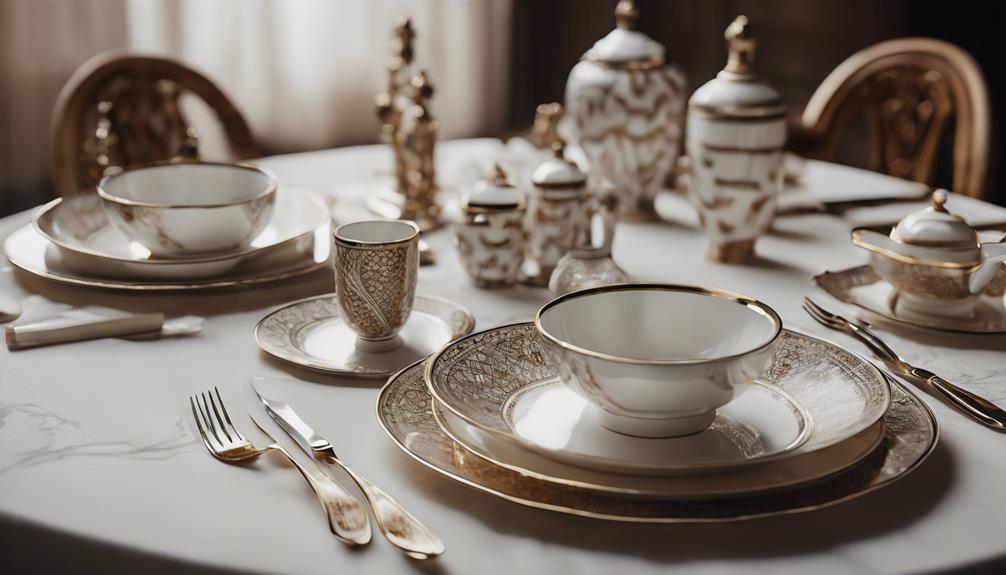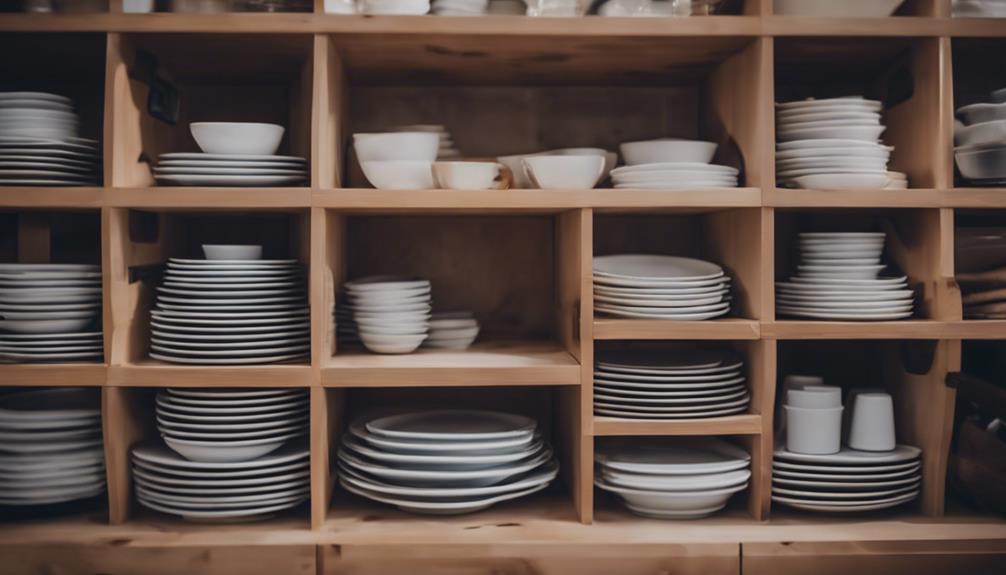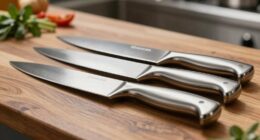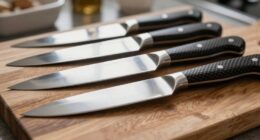Tableware items are used for dining, while kitchenware aids in food preparation. They are crucial in most homes. Tableware materials vary from ceramic, wood, metals, glass, to plastics. Different materials cater to different preferences and occasions, balancing durability and aesthetics. Essential kitchenware includes silicone cooking utensils, sharp knives, and cookware sets. When choosing tableware materials, consider both style and function. Earthy colors in tableware can help create a tranquil dining ambiance. Renting tableware provides variety for themed events and is cost-effective for large gatherings. High-quality knives and separate cutting boards are essential items. Learn more about selecting the right tableware and essential kitchenware pieces.
Key Takeaways
- Tableware includes items for dining, while kitchenware aids in food preparation and storage.
- Materials for tableware include ceramic, wood, metals, glass, and plastics.
- Durability and aesthetics are key factors when selecting tableware materials.
- History shows the evolution of tableware from pottery to precious metals.
- Kitchenware essentials include knives, cookware, utensils, and cutting boards.
Definition of Tableware and Kitchenware
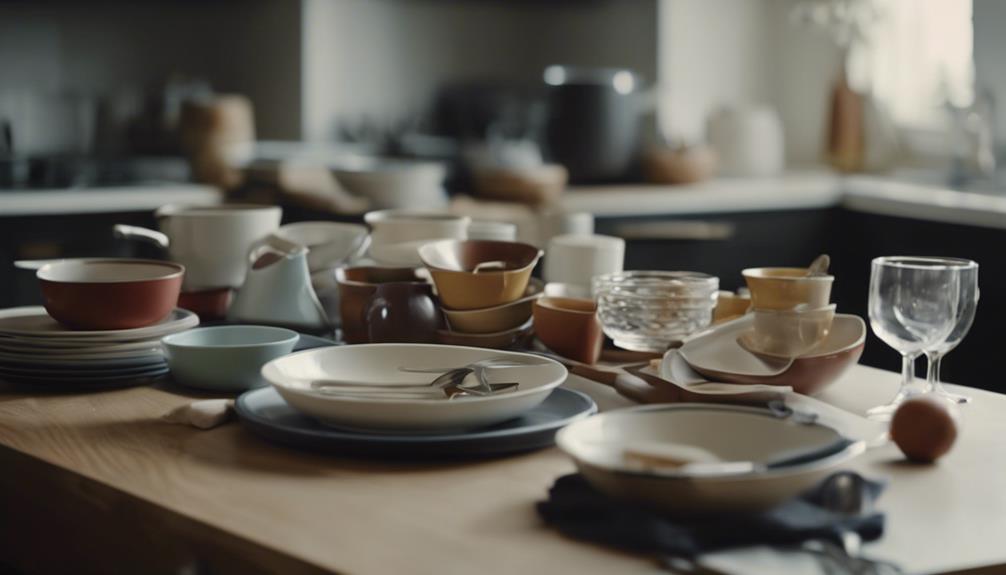
Tableware and kitchenware are essential items found in most households. In the kitchen, you'll find various utensils like kitchen knives, spatulas, and mixing bowls, essential for food preparation. Dinner plates are a common type of tableware used for serving meals. Kitchenware aids in cutting, cooking, and preserving food effectively, making meal preparation more manageable.
Distinctly, tableware serves dining purposes, while kitchenware is vital for food preparation in the kitchen. Tableware encompasses a wide range of items such as gold and silverware, teaware, glassware, and containers for serving meals. On the other hand, kitchenware includes tools like cutting boards and knives, making cooking tasks more efficient. Understanding the difference between tableware and kitchenware can help you organize your kitchen better and make sure you have the necessary items for both serving and preparing meals.
Types of Tableware Materials
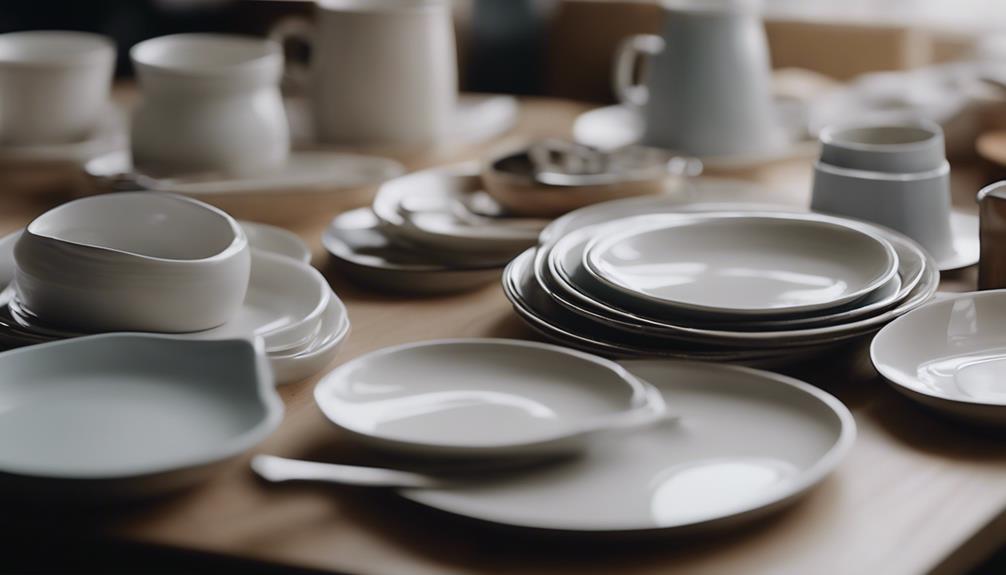
When considering tableware materials, options like ceramic, wood, metals, glass, and plastics provide a range of choices for different needs and styles.
Ceramic materials such as earthenware and porcelain are popular for their durability and visual appeal.
Stainless steel is commonly used for cutlery due to its strength, corrosion resistance, and easy maintenance.
Tableware Material Options
Ceramic tableware materials like earthenware, stoneware, bone china, and porcelain are favored for their durability and aesthetic appeal. Stainless steel is often used for cutlery due to its strength and corrosion resistance. Here is a comparison of some common tableware materials:
| Material | Durability | Aesthetics |
|---|---|---|
| Bone China | High | Elegant |
| Stainless Steel | Very Durable | Modern |
| Ceramic | Sturdy | Classic |
| Wood | Natural Charm | Rustic Feel |
Each material offers unique characteristics to suit different preferences and occasions, from elegant bone china to the modern appeal of stainless steel. Choose the material that best matches your style and functional needs.
Durability and Aesthetics
For a perfect balance of durability and aesthetics in your tableware selection, consider the various materials available to suit your preferences and needs. When choosing tableware materials, here are some options to keep in mind:
- Porcelain: Known for its durability and elegance, porcelain is an excellent choice for formal dining occasions, adding a touch of sophistication to your table settings.
- Stoneware: Highly resistant to chipping and scratching, stoneware is ideal for everyday use in busy households, ensuring your tableware stays looking great even with frequent use.
- Bone China: Prized for its translucency and strength, bone china is a luxurious option for fine dining experiences, elevating your meals with its delicate yet durable nature.
History of Tableware and Kitchenware
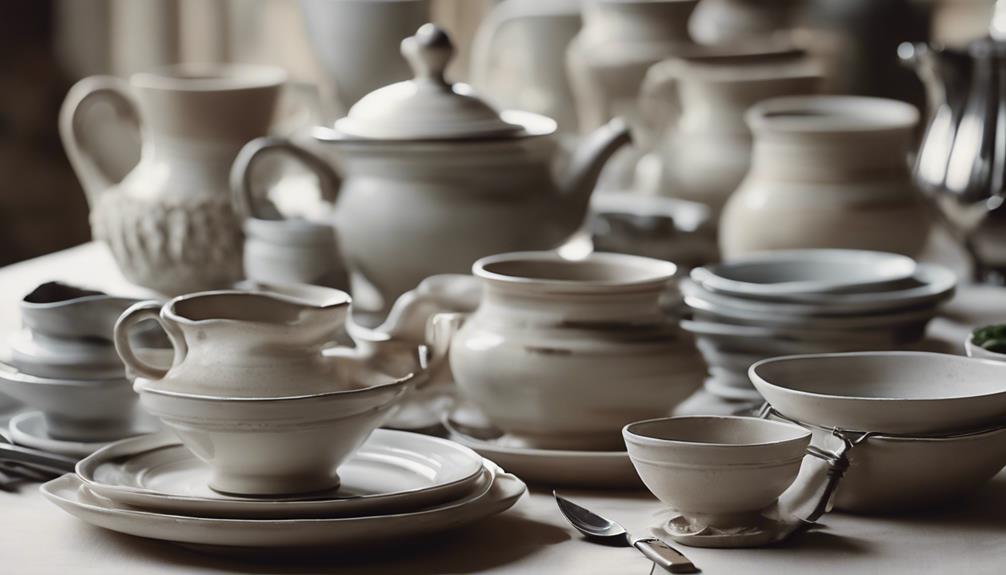
In early history, the focus of pottery for tableware and kitchenware centered more on pots and jars than on flatware. Ancient elites preferred using precious metals like gold and silver for their flatware, showcasing their status and wealth. However, plate melting for financial gain during the Middle Ages resulted in limited surviving examples of these lavish items.
Instead, trenchers, which were bread rounds used as plates, were common in medieval cuisine. Tableware ownership wasn't just about functionality but also served as a symbol of one's prosperity, often regulated by sumptuary laws to control ostentatious displays of wealth.
The evolution of tableware and kitchenware reflects not only changes in culinary practices but also societal norms and economic conditions throughout history. From basic pottery to extravagant metal flatware, the history of tableware and kitchenware offers a glimpse into the cultural significance and practical necessities of dining implements.
Tableware in Western Style
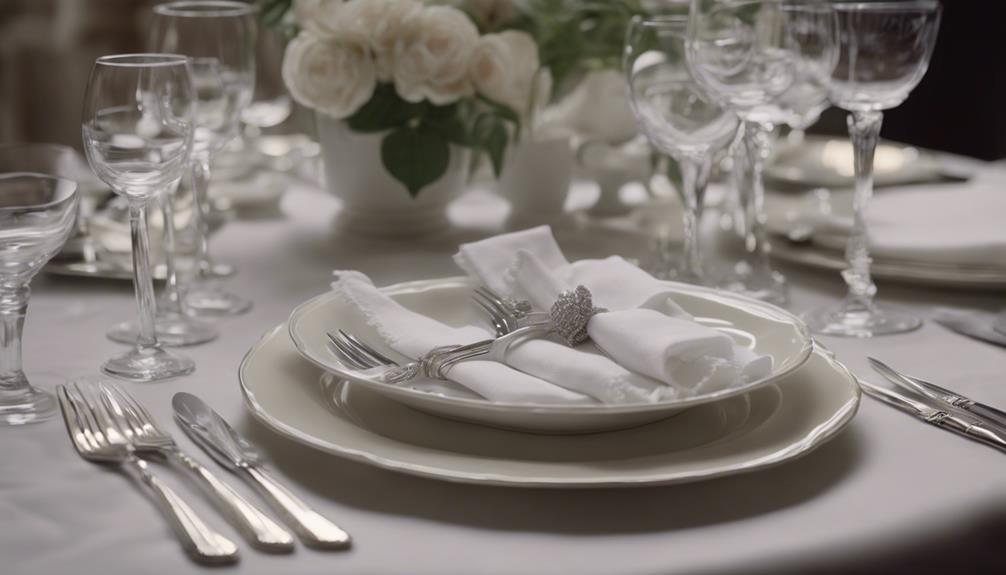
When setting a table in Western style, specific arrangements for cutlery and dishes play a crucial role in enhancing the dining experience. Here are some key features of tableware in Western style:
- Service à la russe and Service à la française: These two main Western table setting styles dictate how cutlery and dishes are arranged, with distinct placements for different courses.
- Cutlery Arrangement: In service à la russe, separate knives, forks, and spoons are provided for each dish, ensuring the right utensils are available throughout the meal.
- Glass Placement: Glasses are set in a specific manner for water, red wine, and white wine, contributing to the overall aesthetic and functionality of the table setting.
Western table settings also include strategic placement of serving dishes like butter dishes and casseroles to streamline food service. Additionally, at formal events, place markers are utilized to indicate seating arrangements following traditional etiquette. These details combine to create a sophisticated and organized dining experience.
Tableware in Chinese Style
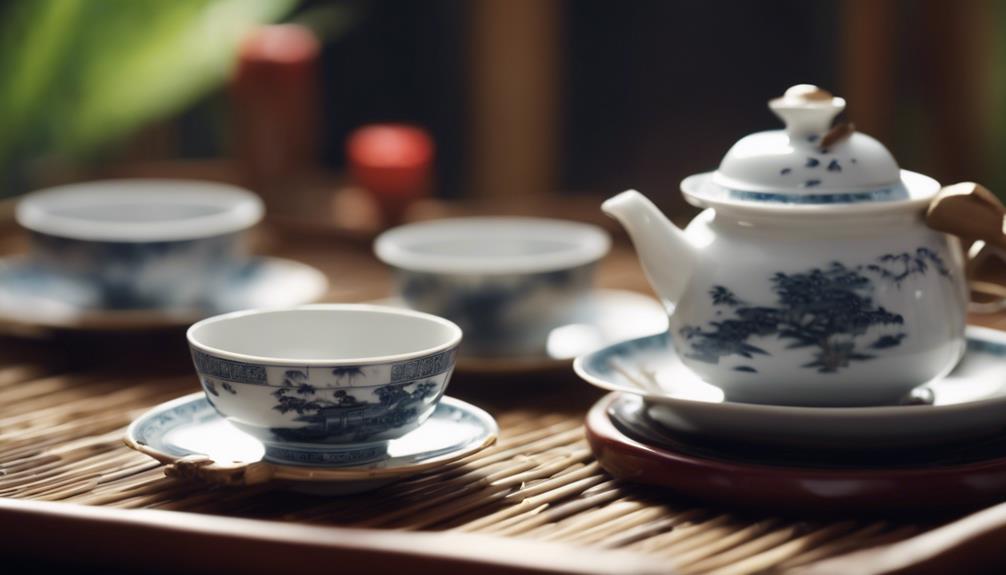
Chinese tableware designs often showcase intricate motifs like dragons and floral patterns, embodying traditional aesthetics.
The table settings in Chinese style commonly include chopsticks, rice bowls, and teacups to reflect cultural dining practices.
Materials like delicate porcelain are favored for their translucent appearance in crafting these exquisite pieces.
Chinese Tableware Designs
Amidst the vibrant tapestry of tableware designs from around the world, the allure of Chinese tableware craftsmanship beckons with its intricate patterns and symbolic motifs.
When exploring Chinese tableware designs, you'll encounter:
- Intricate Patterns: Chinese tableware often features elaborate patterns inspired by centuries-old traditions and cultural symbols.
- Porcelain Teapots: A staple of Chinese tableware, porcelain teapots aren't only functional but also serve as decorative pieces showcasing fine craftsmanship.
- Auspicious Symbols: Red and gold hues, dragons, phoenixes, and lotus flowers are commonly used in Chinese tableware design to symbolize luck, prosperity, and happiness, adding a touch of tradition to dining experiences.
Traditional Table Setting
Interested in experiencing the elegance and tradition of Chinese dining? Traditional Chinese table settings often include delicate porcelain dishes, bowls, and elegant chopsticks. These tableware items showcase intricate designs symbolizing prosperity and good fortune.
Essential to the Chinese dining experience are the tea ceremony utensils, such as teapots and tea cups, which add a touch of authenticity and cultural significance to the meal. The colors red and gold, commonly found in Chinese tableware, represent luck and wealth, enhancing the overall dining experience.
In traditional Chinese table settings, harmony in colors, shapes, and the placement of utensils is prioritized to create a visually balanced and aesthetically pleasing environment for your dining pleasure.
Tableware in Japanese Style
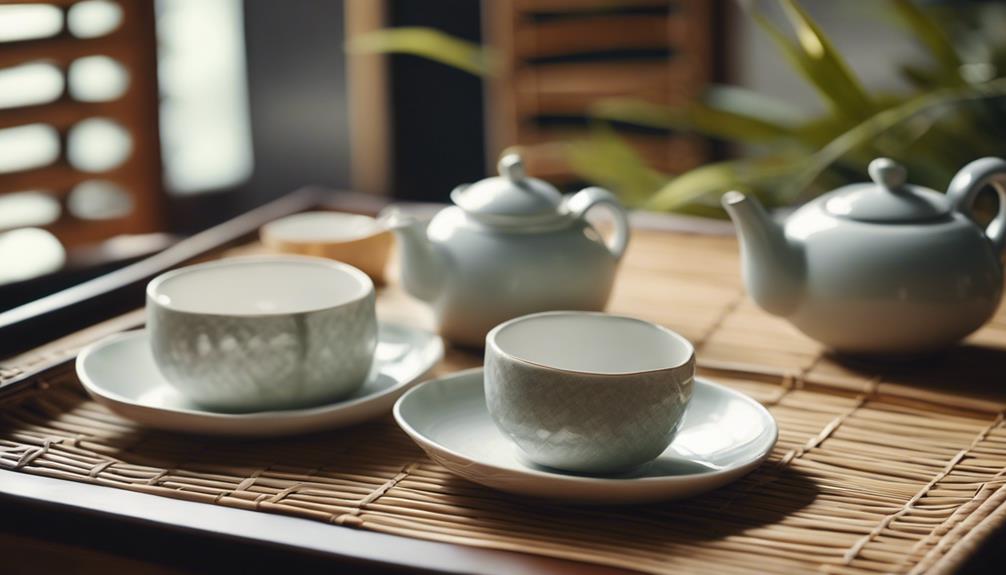
Japanese-style tableware embodies a harmonious blend of minimalist design, natural elements, and soothing colors to elevate your dining experience. When setting your table in a Japanese style, consider these key elements:
- Minimalist Designs: Japanese tableware often features sleek and simple designs, focusing on clean lines and understated elegance. This aesthetic promotes a sense of tranquility and mindfulness during meals.
- Natural Materials: Embracing the beauty of nature, Japanese tableware commonly incorporates materials like wood, bamboo, and ceramic. These natural elements bring a sense of warmth and connection to the environment to your dining experience.
- Earthy Colors: Traditional Japanese tableware tends to use earthy tones such as greens, browns, and muted blues. These colors are chosen to evoke a sense of serenity and harmony, creating a peaceful atmosphere for enjoying your meal in a calming setting.
Choosing the Right Tableware
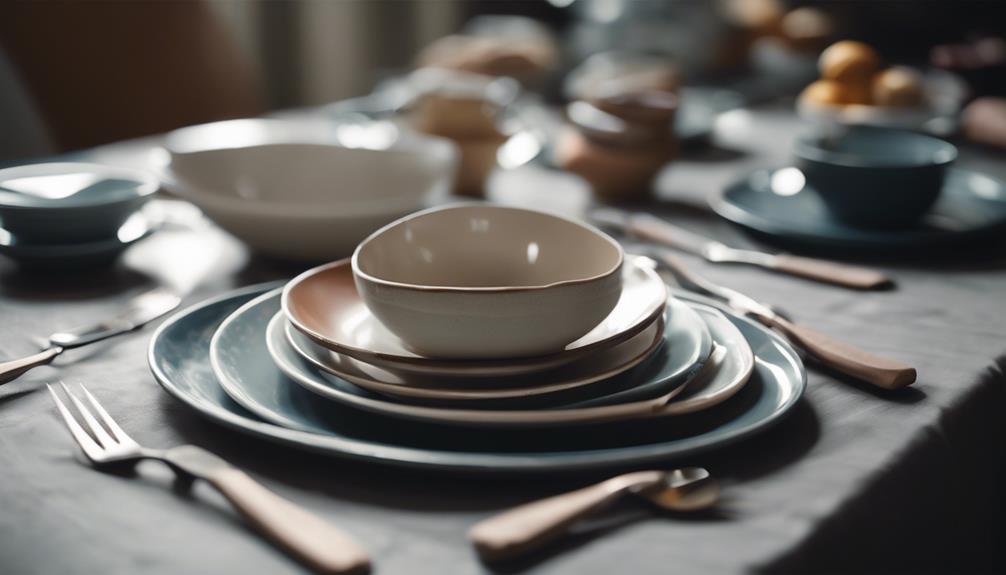
When choosing tableware for an event, consider the formality, menu, and number of guests to ensure a harmonious dining experience. Evaluate the event size, budget constraints, and storage space availability to make an informed decision.
For larger events, renting tableware is cost-effective, while buying may be more practical for smaller occasions. Purchasing quality tableware not only reduces environmental impact with longevity but also provides opportunities for personalization and custom branding.
Rental options offer a variety of choices, making them suitable for themed events. By evaluating your needs based on the event size and budget constraints, you can make a wise choice between renting and purchasing tableware.
Kitchenware Essentials
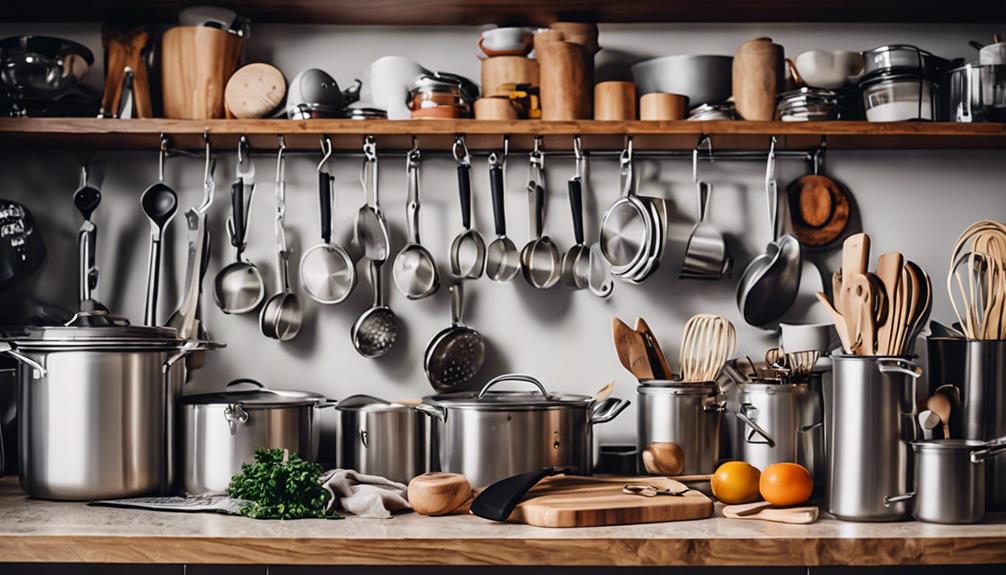
Enhance your culinary experience by equipping your kitchen with essential tools like silicone cooking utensils, sharp knives, cutting boards, measuring spoons and cups, and a cookware set. These items are vital for efficient food preparation and cooking tasks.
Here are three must-have kitchenware essentials:
- Sharp Knives: Invest in a set of high-quality knives with a sharpener to tackle various cutting tasks effortlessly. A good knife makes chopping vegetables and slicing meat a breeze, saving you time and effort in the kitchen.
- Cooking Utensils: Silicone cooking utensils are versatile, durable, and gentle on cookware. They come in various shapes and sizes, perfect for stirring, flipping, and serving your culinary creations without scratching your pots and pans.
- Cutting Boards: Having a few cutting boards in different sizes is essential for maintaining a hygienic food preparation area. Use separate boards for meat, vegetables, and fruits to prevent cross-contamination and ensure food safety. A sturdy cutting board also protects your countertops from damage while providing a stable surface for slicing and dicing.
Frequently Asked Questions
What Does Kitchenware Include?
Kitchenware includes a variety of tools for food prep, such as knives, spatulas, cutting boards, and mixing bowls. It covers utensils for cutting, cooking, and serving food, along with plates and bowls.
Cheese graters, measuring spoons, and cookware sets are essential components. A well-equipped kitchen features silicone cooking utensils, sharp knives, and an organized workspace.
Prioritizing essential tools and maintaining a minimalist approach are key to successful food preparation.
What Is Considered Tableware?
Tableware includes dishes, trays, and utensils used for food distribution and consumption. It encompasses various containers and utensils designed for serving meals.
This category consists of gold and silverware, teaware, glassware, dishes, and decorative pieces. Different types are used for daily dining, special occasions, and formal events.
Choosing the right tableware enhances the dining experience and adds aesthetic value to the table setting.
What Is the Difference Between Tableware and Dishware?
In the world of dining essentials, understanding the contrast between tableware and dishware is essential.
Tableware encompasses a wide array of items used for dining, from dishes to silverware. On the other hand, dishware specifically refers to plates, bowls, and serving dishes.
While tableware covers a broader spectrum, dishware plays a vital role in serving meals. So, when setting a well-equipped table, knowing the distinction between the two is important.
What Is the Difference Between Tableware and Utensils?
When distinguishing between tableware and utensils, it's important to note their specific roles. Tableware pertains to items used for serving and eating food, such as dishes and trays.
On the other hand, utensils are tools designed for food preparation in the kitchen, like knives and spatulas. While tableware is for food distribution and consumption, utensils are primarily for cooking purposes.
Understanding this difference helps you organize your kitchen essentials effectively.
Conclusion
Now that you know the difference between tableware and kitchenware, it's time to elevate your dining experience.
From elegant Western styles to intricate Chinese designs and minimalist Japanese aesthetics, there's a world of options to explore.
So, next time you set the table or cook up a storm in the kitchen, choose your tableware and kitchenware wisely to make every meal a memorable one.
Stay tuned for more tips and tricks to enhance your culinary adventures!
